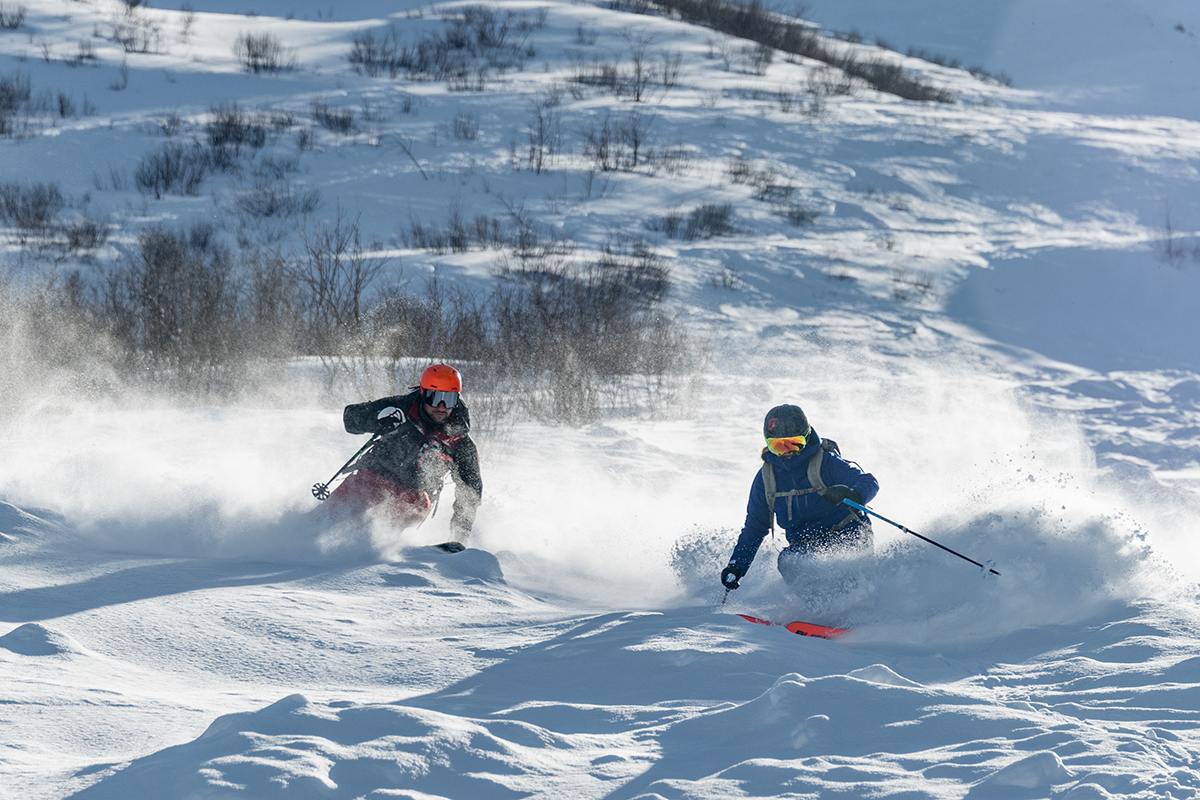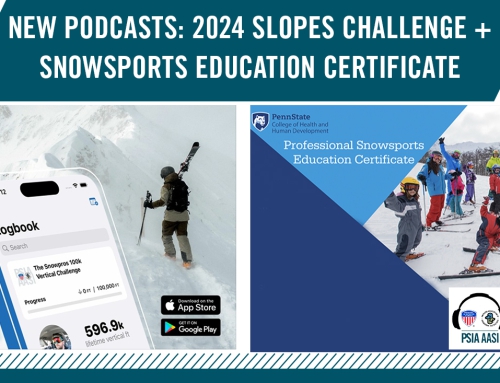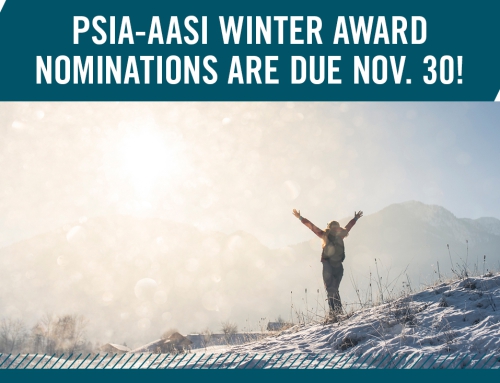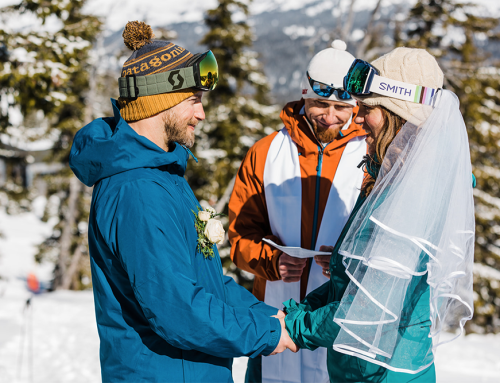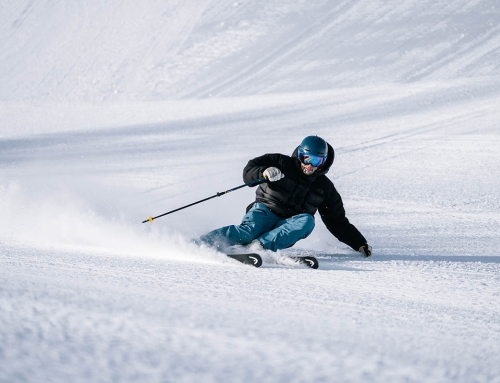32 Degrees: How Foot-to-Foot Movement Aids Turn Transitions
This article by PSIA Alpine Team member Brenna Kelleher appeared in the Spring 2023 issue of 32 Degrees. You can read the entire magazine right here.
I have one rule in skiing: There are no absolutes… except for one; you have to go downhill. It’s important to remember that, when we think in absolute terms or finality, we lose flexibility and diversity in skiing; we get stuck, forget to move, and become stiff. Skiing is about constant movement.
You might hear a particular technique or tactic being called the “PSIA style” or “PSIA way of skiing,” especially when it comes to the Alpine Skiing Fundamentals. But this is a false interpretation. The fundamentals are centered around diversity in how we perform and apply them in different terrain and snow conditions. They allow us to have style and freedom in how we ski, and at different levels – depending on how they’re executed and the outcome we’re looking for.
Take, for example, the fundamental that encourages skiers to “Control pressure from ski to ski, and direct pressure to the outside ski.” It’s all about outside ski pressure, right?! We all strive to get to the outside ski earlier, but let’s explore the different applications of how we use the outside ski, based on the outcome we’re looking for. For instance, consider speed versus technique in a racecourse and, alternatively, speed control versus technique in off-piste conditions.
Desired Outcome: Winning a Race
When we think about getting to the outside ski early, we often look to skiers who are the fastest at doing everything – ski racers. However, how we get to the outside ski early is not always about speed; it may be a question of where, in the turn, we apply that move. Maybe we want to execute the top of the turn differently to get to that outside ski sooner.
The first attributes to look for in a skier is their stance and whether they’re balanced. Or, more specifically, their stance in the transition from one turn to another. How does the skier stand through the transition? Is their upper body coming forward across the hill or are they leaning back? Is their body inside the end of the turn or are they out over the old outside ski? Is there some variation in how they blend flexion and extension of the ankle, knee and hip? When any one of these elements is off, it affects the outcome of how the skier directs pressure to the outside ski.
When looking at carving or racing, we are looking for the angles – angles in the body and on the ski. When coaching for speed, it’s the transition that matters most; how the skier moves to the new ski, where the center of mass is directed, and whether they’re disciplined throughout. Instead of considering how the skier “moves” to the outside ski, think more about how the skier engages the new outside ski through transition. When you tell someone to move, they usually take it to mean they should move their whole body. Adjusting the language allows the skier to think about the edge as independent from the body; therefore, the brain narrows the focus to the body part closest to the snow – the ankle – and how to engage the new outside ski edge.
This, in turn, keeps the skier more balanced and grounded through the transition, enabling greater control as they direct pressure to the new outside ski. The outcome is less whole-body movement vertically, more movement directed down the hill, and a fast and fluid run. If you pause the action, you’ll see the ski is flat through the transition and the skier has good separation of the lower leg and upper body.
Desired Outcome: Crush the Off-Piste
Okay, so how does this apply to off-piste skiing? Well, we look for the same thing. The only difference is that the angles are not as extreme. Speed control is the first thing people are concerned with when they get in variable snow conditions and steeps, which sends a message to the brain to go for huge edge angle. Wrong! This generally results in the same problem seen in carving – except the feedback is usually more immediate and extreme. They move their whole body to put the ski on edge. The result is a high edge angle with no lateral separation, sending the skier shooting across the hill.
Have you ever been in steeps and felt like your turns were super-fast without control? Now you know why; you were moving your whole body to create edge angle. In this type of terrain, using a flat ski is the most effective way to get back over the outside ski. Many times, people freak out if told to use less edge angle, but this is precisely what they need to get back on their feet and connected to the snow.
Encourage students to use edge angle appropriate to the slope – which, essentially, is the edge angle they’d use when simply standing on that hill. Once the skier gets more comfortable skiing on flatter skis, they’ll eventually want to use more edge. That’s okay, but when it comes to foot-to-foot pressure, it’s smart to work with skiers on discipline and independent lower leg actions. Here are a few activities I like to use to highlight the lower leg engagement:
- Tracers: In flat terrain, practice gliding on a flat ski on one leg and rolling the other ski from “edge to edge” in the air to trace the path of the other ski.
- Carved White Pass Turns: The White Pass turn is a one-footed drill in which the skier lifts the outside ski off the snow just before turn initiation and places it back down at turn finish. When working on White Pass Turns with a carve element, you’ll get going fast, so start out on easy green terrain then work your way onto blue terrain.
- Wedge Christies: Yes, it all starts with these lower-level basic drills and the fine movements of the lower leg. Start the turn in a wedge and, during the shaping phase, steer the inside ski to bring the skis parallel.
- Carved Cowboy Turns: Make a turn with a wide stance, exaggerating the flattening and tipping movement of the inside, initiating ski – which has a bow-legged appearance and turn initiating. Doing this drill in gentle terrain helps with fore/aft movement and lower-leg tipping.
- Sideslips: This, of course, refers to sliding sideways to the length of the skis, and people who ski with me know I love sideslipping when teaching in the off-piste. Mostly because it helps skiers adjust their stance to find balance in the fall line. Quick tip: If the skier puts a lot of weight on the uphill ski and travels across the hill, they’re not doing it correctly! Sound familiar? Yes, that means the skier is using their whole body, not the lower leg, to sideslip. How to correct it? Flatten the ski.
As you can see, there’s a good reason that controlling pressure from ski to ski and directing pressure to the outside ski is fundamental to good skiing. But there’s no single, absolute approach to applying it on the hill. As with most technique and tactics, much depends on desired outcome. Learn the fundamentals, understand the mechanics, and then explore the possibilities!
Brenna Kelleher is a member of the PSIA-AASI National Team, based in Big Sky, Montana. She grew up ski racing and finds that coaching people to go faster with better technique instills confidence to go anywhere on the mountain. She wishes to thank longtime Killington (Vermont) instructor Neal Magnus (Alpine Level III), whose lifelong passion for both skiing and photography come together in the accompanying race photos from the 2022 Killington World Cup.

